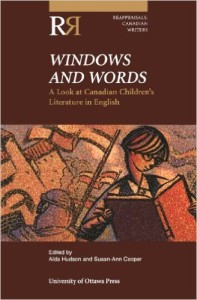 Lory Hess penned this review.
Lory Hess penned this review.
Most people’s knowledge of Canadian children’s literature runs the gamut from Anne of Green Gables to . . . well, Anne of Green Gables. Thus it comes as no surprise that in this volume of essays taken from papers, talks and panel discussions given at the Canadian Children’s Literature Symposium in Ottawa in 1999, over a third of the pieces concern Anne’s creator L. M. Montgomery, Canada’s “greatest literary export” (in the words of contemporary author Tim Wynne-Jones).
I have to confess that my own knowledge of the genre is fairly Montgomery-centric, so I can’t really pass judgment on the critiques of other authors contained here, though a few were intriguing. I’d like to have a look at Tim Wynne-Jones’ own novel The Maestro, about a troubled young boy’s relationship with a Glenn Gould-like recluse. And I definitely intend to search for Truly Grim Tales by Patricia Galloway, a collection of fairy-tale retellings. The story discussed in the present volume is a version of “Little Red Riding Hood” that begins “The giant clams were the real danger.” Life in the Maritimes seems to have gotten more exciting since Anne’s day.
And what about Anne? Six essays discuss her or Montgomery’s next most famous heroine, Emily of New Moon. I read all the volumes in both series in my teens (most of them repeatedly), and I’d be interested to see some insightful criticism of Montgomery’s work — which may be overexposed, but obviously has some enduring qualities that other, more ephemeral Victorian sentimental tales do not. However, I do get impatient (as I’ve expressed in previous reviews) with critics whose own literary abilities are severely limited, thus making one wonder what right they have to be analyzing a creative artist. What is the point of academic writing, anyway? What comes of it that is actually as worthwhile, thought-provoking, or innovative as the writing it discusses? Precious little, it seems to me.
One example here is an unintentionally amusing piece titled “L. M. Montgomery and Everybody Else: A Look at the Books” by Virginia S. Careless. Careless, who laboriously explains that “my approach in explaining the similarities found in Montgomery’s and her antecedent authors’ works is what in anthropological terms could be called a structuralist-cultural ecological one,” starts off with four pages that are simply a barrage of citations: who has compared Montgomery’s work to which other books, what particular aspects have been compared, which characters have been compared, and claims of intentional deriviation ordered neatly “from the mildest to the strongest.”
The essay goes on for 22 more dry-as-dust pages to argue (after a crash course in anthropological theory) that oft-noticed similarities between Anne of Green Gables and Rebecca of Sunnybrook Farm by Kate Douglas Wiggin were not a result of plagiarism by Montgomery, but of innocent similarities in time, place, and authorial experiences. A valid point, perhaps, but surely it could have been expressed more concisely. (There is also an eight and a half page bibliography, if you haven’t had enough!)
On the other end of the spectrum is Irene Gammel’s “The Eros of Childhood and Early Adolescence in Girl Series: L.M. Montgomery’s Emily Trilogy,” which applies overheated feminist body theory to everything from Emily’s imaginary friend, Emily-in-the-Glass (“Montgomery instantiates the girl’s authority over her body-imaging in erotic moments”) to her affection for animals (“giving Aunt Elizabeth lessons on the haptic pleasures that can be drawn from cats”).
Not that there isn’t some good material here — it’s true that Montgomery complained that “the public and the publisher won’t allow me to write of a young girl as she really is,” suggesting that she did wish to portray more raw, less insipid aspects of feminine development. Emily is in many ways an extraordinary protagonist for her time. Her imaginative raptures are powerfully portrayed, and have influenced many subsequent authors, including Margaret Atwood, Alice Munro, and Kit Pearson. But there’s a danger in overdoing the hunt for sexual imagery: it can make a serious subject seem ridiculous. Sometimes a banana is just a banana, after all.
(University of Ottawa, 2003)
